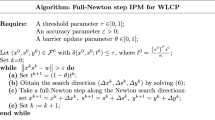Abstract
We describe an algorithm for the monotone linear complementarity problem (LCP) that converges from any positive, not necessarily feasible, starting point and exhibits polynomial complexity if some additional assumptions are made on the starting point. If the problem has a strictly complementarity solution, the method converges subquadratically. We show that the algorithm and its convergence properties extend readily to the mixed monotone linear complementarity problem and, hence, to all the usual formulations of the linear programming and convex quadratic programming problems.
Similar content being viewed by others
References
R.W. Cottle, J.-S. Pang and R.E. Stone,The Linear Complementarity Problem (Academic Press, 1992).
O. Güler, Generalized linear complementarity problems, Math. Oper. Res. 20(1995)441–448.
O.L. Mangasarian, Error bounds for nondegenerate monotone linear complementarity problems, Math. Progr. 48(1990)437–445.
G.J. Minty, Monotone (nonlinear) operators in Hilbert space, Duke J. Math. 29(1992)341–346.
S. Mizuno, Polynomiality of Kojima-Meggido-Mizuno infeasible-interior-point algorithm for linear programming, Technical Report 1006, School of Operations Research and Industrial Engineering, Cornell University, Ithaca, NY (1993).
R.D.C. Monteiro and S.J. Wright, Superlinear primal-dual affine scaling algorithms for LCP, Math. Progr. 69(1995)311–333.
R.D.C. Monteiro and S.J. Wright, Local convergence of interior-point algorithms for degenerate monotone LCP, Comp. Optim. Appl. 3(1994)131–155.
F.A. Potra, An infeasible interior-point predictor-corrector algorithm for linear programming, Technical Report 26, Department of Mathematics, University of Iowa, Iowa City, IA (1992), to appear in SIAM J. Optim.
S.J. Wright, A path-following infeasible-interior-point algorithm for linear complementarity problems, Optim. Meth. Softw. 2(1993)79–106.
S.J. Wright, An infeasible-interior-point algorithm for linear complementarity problems, Math. Progr. 67(1994)29–52.
X. Xu, P. Hung and Y. Ye, A simplified homogeneous and self-dual linear programming algorithm and its implementation, Manuscript (1993).
Y. Ye and K. Anstreicher, On quadratic and\(O(\sqrt {nL} )\) convergence of a predictor-corrector algorithm for LCP, Math. Progr. Series A 62(1993)537–551.
Y. Ye, M. J. Todd and S. Mizuno, An\(O(\sqrt {nL} )\)-iteration homogeneous and self-dual linear programming algorithm. Math. Oper. Res. 19(1994)53–67.
Y. Zhang, On the convergence of a class of infeasible-interior-point methods for the horizontal linear complementarity problem, SIAM J. Optim. 4(1994)208–227.
Author information
Authors and Affiliations
Additional information
This research was supported by the Office of Scientific Computing, U.S. Department of Energy, under Contract W-31-109-Eng-38.
Rights and permissions
About this article
Cite this article
Wright, S.J. A path-following interior-point algorithm for linear and quadratic problems. Ann Oper Res 62, 103–130 (1996). https://doi.org/10.1007/BF02206813
Issue Date:
DOI: https://doi.org/10.1007/BF02206813




